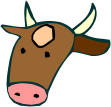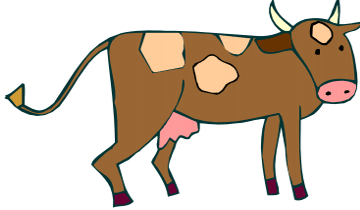| Organic Livestock |  |
| Organic Livestock |  |
Origins
The identity of all organic animals and edible and non-edible animal products must be recorded. Normally if a farmer wants to sell, label or represent his livestock products as organic they must be from livestock that has been under organic management from the last third of gestation or hatching. There are some exceptions to this as I will explain below.
Poultry or edible poultry products must live under organic conditions from the second day of life at the latest.
Dairy products must come from animals that have been kept organically for a year before the products are sold. When a whole herd of cows are to be converted to organic production the farmer can feed them 80% organic feed for the first nine months and 100% organic feed for the last three months.
Animals for breeding can be brought from non-organic management onto an organic farm at anytime providing they are not into the last third of pregnancy.
Breakfast, Lunch and Dinner
We organic animals enjoy nice healthy natural meals. Grass is my personal favorite but there are other choices to be had. All our food must be totally organic, and this includes the pasture and fodder. Some synthetic and non-synthetic substances are allowed and can be used as food additives and supplements, just enough should be added and no more, to make sure we get the right amount of vitamins and minerals!
We should never be given anything that is in violation of the Federal Food, Drug and Cosmetics Act. Plastic pellets should not be used as roughage. Our food must not contain any urea or manure. Mammals and poultry must not be fed mammalian or poultry slaughter by-products.
I just donít know how non-organic animals put up with a menu like that!
Home
Animals must have appropriate housing, pasture and sanitation in order to live happy healthy lives and prevent the spread of disease and parasites.
Animals may be put in temporary confinement if required by the animalís stage of production, if there are harsh weather conditions, if there is any health or safety risk to the animal, or if there is a risk that the soil or water quality is not up to standard.
 |
|
Health Care
In order to prevent ill health in his livestock, there are certain things a farmer must do.
Any medical attention we might need must be administered in a way that causes as little pain and stress as possible. We must be given any vaccines and other veterinary biologics that we need. If preventative measures are not enough and we get sick anyway certain synthetic medicines are allowed. Some parasiticides can be used on breeder stock, except during the last third of pregnancy or when lactating, or on dairy stock, but only 90 days prior to the production of milk or milk products.
Medical treatment should not be withheld from any animal just to keep its organic status. If everything else has been tried and failed then non-organic medicines must be used to restore health. This does mean that the animal cannot then be labeled as organic (Iíd rather that than die though!).